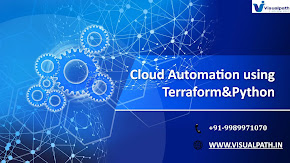Cloud Automation – Use of automated tools in Cloud Environments.
Cloud Automation can be referred as the
application of processes and tools in an effort to reduce the Human
intervention managing and configuring the Cloud environments. Cloud automation
involves the use of specialized tools and scripts to automatically manage and
optimize cloud infrastructure, services, and workflows. It aims to reduce
manual intervention, minimize errors, and accelerate repetitive tasks. - Cloud Automation
Online Training
Key Components associated with Cloud Automation:
Orchestration:
Orchestrating complex workflows and tasks to ensure seamless integration and communication between different cloud services.
Configuration Management:
Automating
the setup and configuration of cloud resources to maintain consistency and
compliance. - Cloud Automation Training in
Hyderabad
Policy-driven
Automation:
Implementing
policies to automatically scale resources, allocate budgets, and enforce
security measures.
Increased
Efficiency:
Automating routine tasks allows IT teams to
focus on strategic initiatives, reducing the time and effort spent on manual
operations. - Cloud
Automation Training
Scalability:
Cloud automation enables organizations to
scale resources up or down based on demand, ensuring optimal performance
without unnecessary costs.
Cost
Optimization:
Automation helps control costs by
efficiently utilizing resources, identifying and eliminating idle resources,
and optimizing workload distribution.
Enhanced Security:
Implementing consistent security policies
through automation reduces the risk of human error and ensures a standardized
security posture across the cloud environment. -Cloud
Automation using terraform and python
The scope of cloud automation is extensive and
encompasses various aspects of IT operations and management within a cloud
computing environment.
Here's
is a breakdown of some of the key areas within the scope of cloud automation:
Infrastructure
Provisioning and Management:
Automated
creation and configuration of virtual machines, storage, and networking
components. Infrastructure as Code (IaC) implementation for defining and
deploying infrastructure resources in a consistent and repeatable manner.
Configuration
Management:
Automation
of configuration tasks to maintain consistency across servers and applications.
Enforcing and managing configurations to meet compliance and security
standards.
Application
Deployment and Orchestration:
Automation
of application deployment processes to streamline releases.
Orchestration
of complex workflows involving multiple services and components.
Auto-scaling
and Resource Optimization:
Dynamic
scaling of resources based on demand to ensure optimal performance and cost
efficiency. Identification and elimination of idle resources to optimize
resource utilization.
Continuous
Integration and Deployment (CI/CD):
Implementation
of CI/CD pipelines for automated testing, integration, and deployment of
applications.
Facilitation
of rapid and reliable software releases.
- Cloud Automation Certification Online Training
Cloud
automation is not just a trend but a necessity in the modern IT landscape. By
embracing automation, organizations can achieve operational excellence, reduce
costs, and position themselves for future growth. As the cloud continues to
evolve, mastering automation is a key factor in staying competitive and
resilient in an ever-changing business environment.
Visualpath is the
Best Software Online Training Institute in Ameerpet, Hyderabad. Avail complete Cloud Automation Online Training
by simply enrolling in our institute,
Hyderabad. You will get the best course at an affordable cost.
Attend Free Demo
Call on - +91-9989971070.
Visit https://www.visualpath.in/cloud-automation-with-python-terraform.html


Comments
Post a Comment